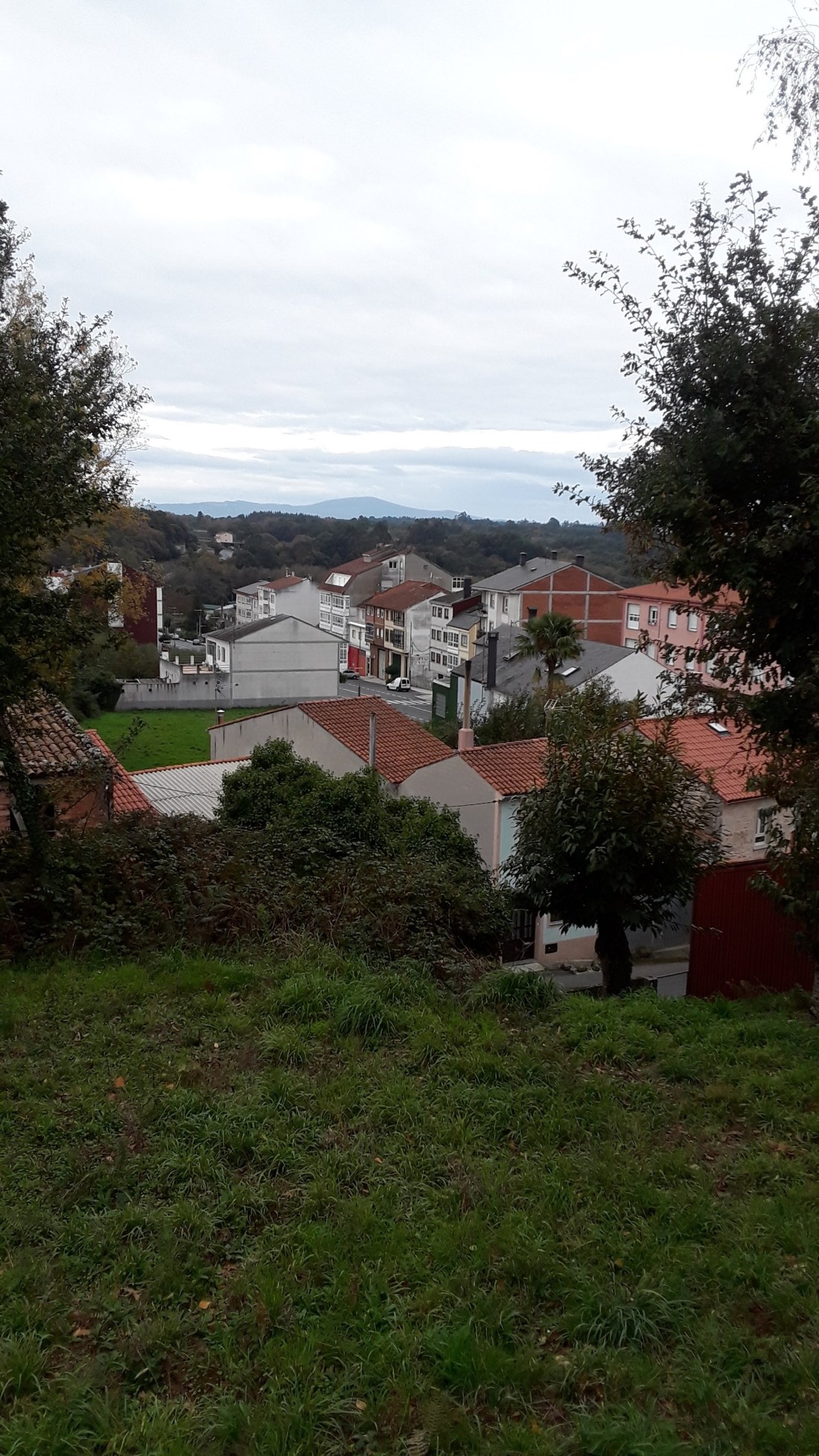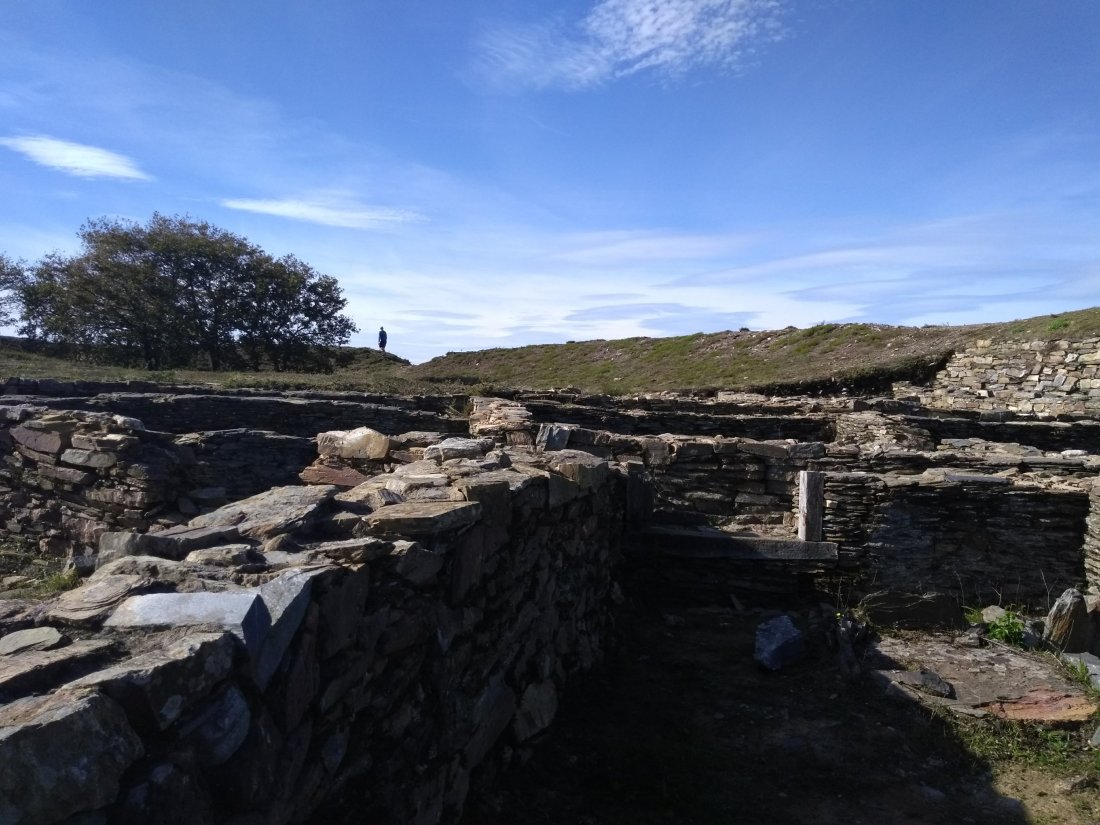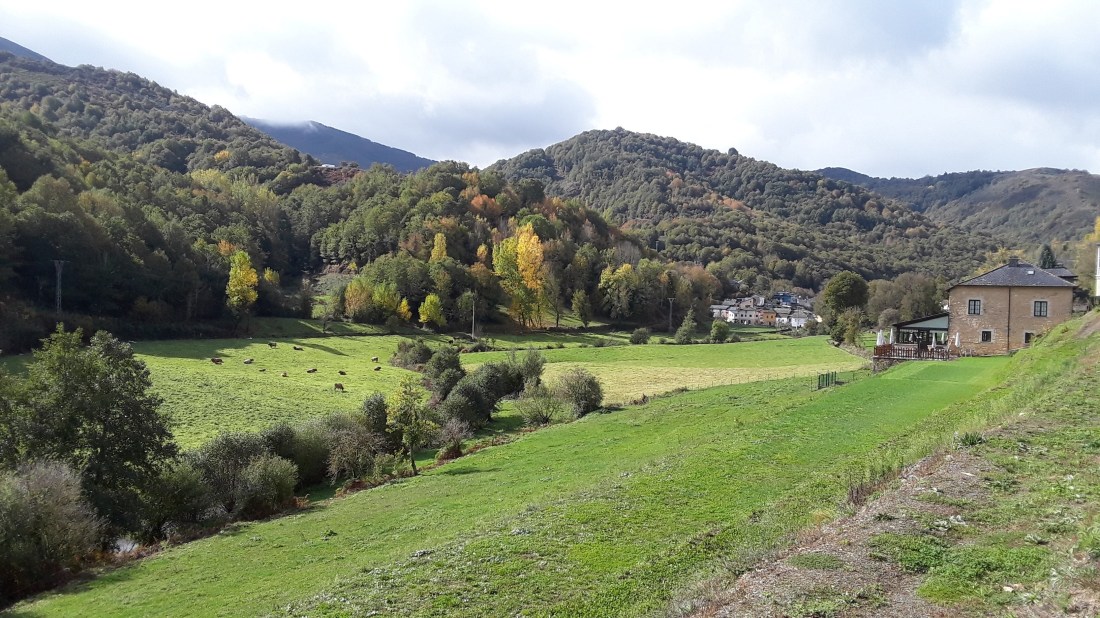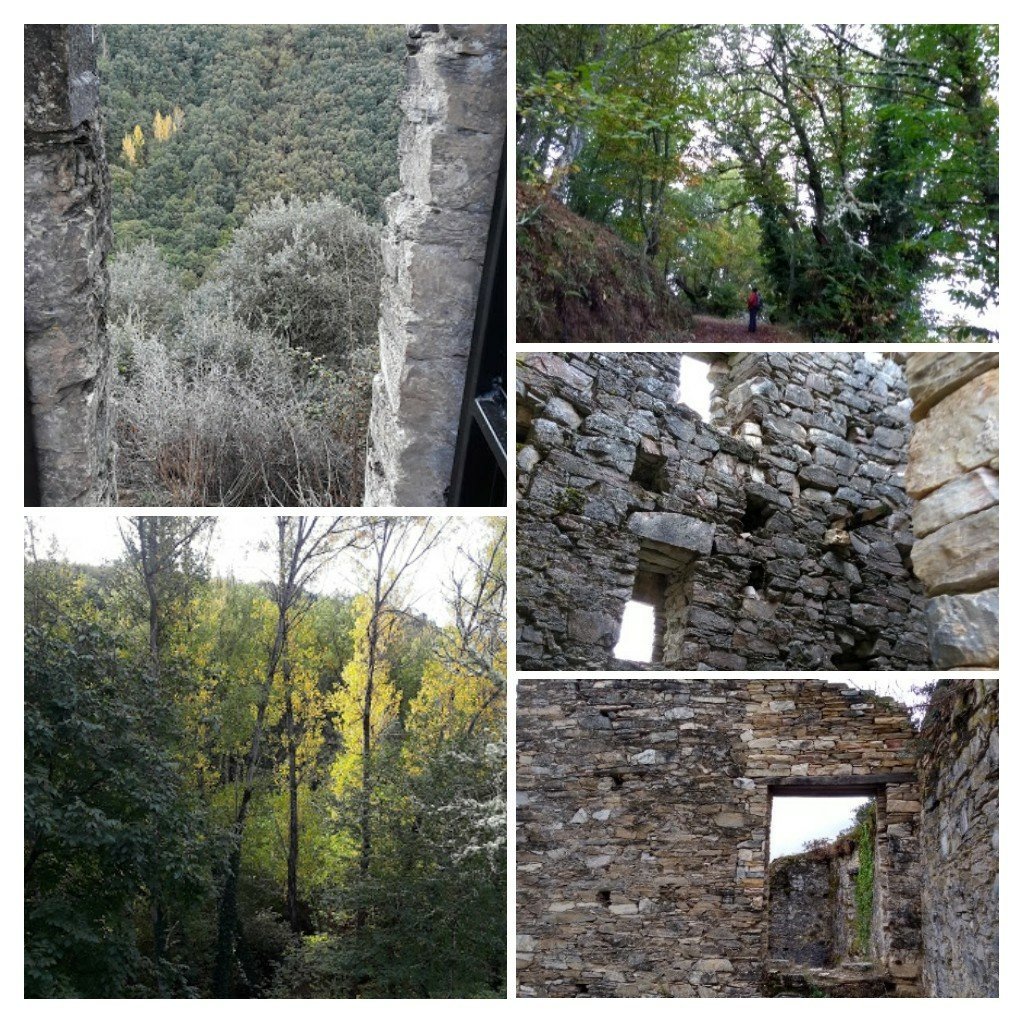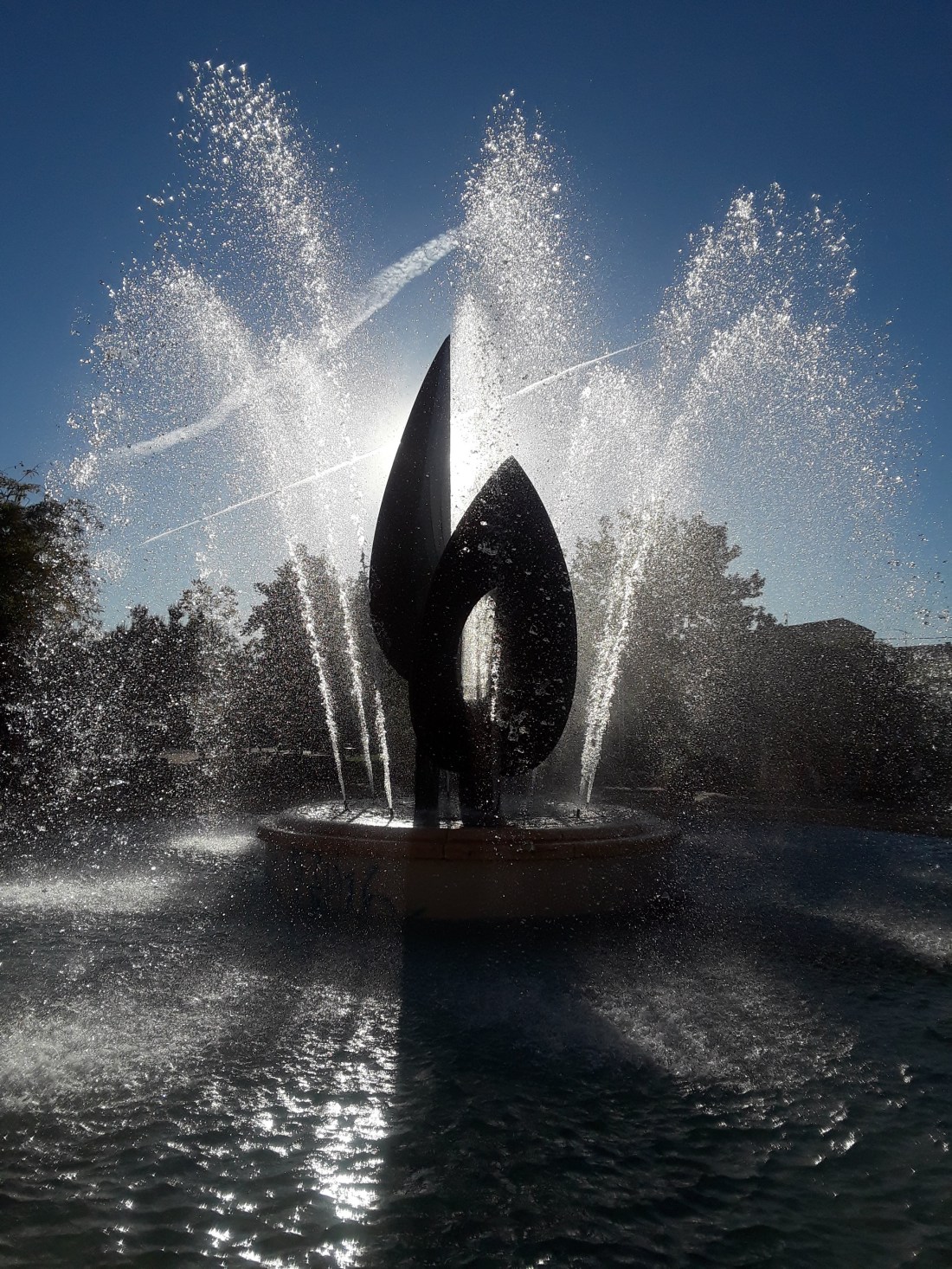October 27-31, 2019
Waking to a sunrise happens often when backpacking, as the brightening dawn brings color straight through tent walls. First light on the Camino requires the conjunction of a window facing east and a view unblocked by other buildings. The morning we woke in Casa Perdigueida, Castromaior, we were rewarded with a truly extraordinary symphony of color!

***************
Walking the Camino brings many chances to eat locally produced food. From collard greens in a home garden to cheese from a local dairy, we enjoy eating our way across Spain! Here is a mosaic of pastoral scenery, often very close to cities, as well as two different harvest storage bins.

**********
The Casa Perdigueida, in Castromaior, displayed an unusual tool upon the wall in their restaurant. Curiosity overcoming shyness from my broken Spanish, I asked the cook/waitress, “¿Que hace?”

With very patient Spanish, repeating the most important nouns several times, the woman conveyed that this yoke was used to harness a horse with a cow (caballo y vaca).
Encouraged by my success in communicating with this considerate local, I asked her the name of the flower painted upon a weathered board. I had noticed the same flower earlier, growing by the doorway.


“¿Que nombre?” My mangled Spanish assisted my persistent curiosity.
“Marguerite,” the woman smiled. Then pointing to the painting, and, with a mixture of slowly pronounced Spanish and extravagant gestures, she managed to convey that she was the artist! How awesome!
**********
“Enter every church that has an open door.” Following this informal rule can bring adventure spanning a gamut of experiences from peace and beauty to confusion and simple bafflement.
As we entered the small village of San Xulian do Camino, the church’s open door beckoned. Jay and I stepped inside to see a small sanctuary with beautiful colors of wooden beams, whitewashed walls, and a rainbow of flowers. Soft music played over hidden speakers, adding to the contemplative atmosphere.

A volunteer stamped our pilgrim passports, then we slipped into a pew, happy to appreciate this meditative moment. Hysterical barking outside broke our reverie, followed by raised voices in various languages. We never learned the source of the muddle, but decided it was time to continue walking.
*********”
A café, O Fogar do Camiñante (Home of the Wayfarer), in the town of Casanova, enticed us with a sign advertising crepes. As we dithered in the street, a smiling waitress handed us menus and, with a wave of her hand, indicated our choice of outdoor tables. Who could reject such an invitation?
The trailside table allowed us to watch as dozens of pilgrims passed by, all seemingly immune to this lovely oasis. We also saw three sheep being urged along by a shepherdess wearing dress slacks and a chic Halloween sweater.
Our lunch consisted of crepes with champiñones y queso (mushrooms and cheese), followed by crepes topped with mermelada de bayas del bosque (forest berry jam). Everything tasted so fresh!
Once again, curiosity overcame shyness. “La comida es muy deliciosa. ¿De donde son los champiñones?”
The owner’s face glowed with pride at my interest. “Una granja a cinco kilómetres de aquí. Tenemos muchos pimientos, tomates, verduras…” Once again, eating local products proved to be an incredibly delicious choice!
**********
Having time to stop and see the sights is part of the fun of walking slowly. In the town of Furelos, a sign invited us to visit the Casa Museo de Furelos.

Once again we stepped back in time, looking at relics of a not so distant past. The museum docent told us stories of his grandmother’s house, where the giant hearth always had a fire with a pot of soup simmering.
He pointed out the kitchen benches with nest boxes underneath. “Chickens roosted here,” he explained. “To get an egg, you just reached under the bench.”
Another display showed biscuit dough being mixed upon a board, instead of in a bowl. “Oh wow!” I exclaimed. “I can remember my grandmother mixing biscuits that way!”
I’ve got to admit, it’s rather amazing to find ones own experiences showcased in a museum!
**********
Walking from Melide to Ribadiso, water streamed from the sky, thoroughly soaking everything, including us! Though my body and pack were dripping, I couldn’t help enjoying the sensation of tiny drops massaging my head through the rain hood. This video shows the day.
Meson Ribadiso, the only restaurant in town, banished our day of rain with Galician lentil soup, roasted sweet peppers, salad, and grilled hake, then tarta de queso and pastel de chocolate for dessert.
With stuffed stomachs, we wobbled along the only street, stopping at the edge of town to watch retreating clouds give a hint of blue sky for tomorrow.
I thought of two pilgrims we had met, Angela and Debby. Eight years ago, they sold their house and began to travel. Angela told us, “When an opportunity presents itself, grab the moment! There are no guarantees in life.”
Debby’s advice built upon Angela’s thoughts. “In the end, things are not important. It is your memories that stay with you. Make memories instead of collecting things.”

